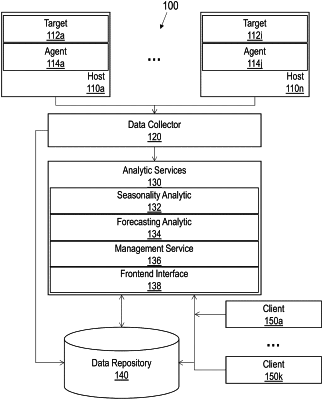| CPC G06N 20/00 (2019.01) [G06N 5/02 (2013.01)] | 20 Claims |

|
18. A system comprising:
one or more hardware processors;
one or more non-transitory machine-readable media storing instructions which, when executed by the one or more hardware processors, cause:
receiving a set of time-series data that tracks metric values of at least one computing resource over time;
responsive to receiving the time-series data, detecting a subset of metric values that are outliers, wherein the subset of metric values are associated with a plurality of timestamps;
mapping each respective timestamp of at least a subset of the plurality of timestamps to one or more respective encodings, wherein a same timestamp for a same outlier is mapped to a plurality of different encodings including a first encoding that indicates where the same timestamp fits relative to a first type of monthly pattern and a second encoding that indicates where the same timestamp fits relative to a second type of monthly pattern, wherein the first encoding differs from the second encoding based on differences in where the same timestamp fits relative the first type of monthly pattern compared to the second type of monthly pattern due to varying seasonal irregularities;
selecting at least one type of seasonal pattern to train a machine learning model based on said mapping, wherein selecting the at least one type of seasonal pattern includes:
iteratively determining a mapping count relative to an opportunity count for each encoding of the plurality of different encodings;
generating a candidate set of encodings that includes encodings where the mapping count relative to the opportunity count exceeds a threshold, wherein encodings where the mapping count does not satisfy the threshold are not added to the candidate set of encodings;
ordering the candidate set of seasons by at least one of duration or complexity;
after ordering the candidate set of seasons, removing encodings from the candidate set that account for less than a threshold number of outliers;
training a machine learning model based on at least one remaining encoding in the candidate set of encodings to learn the at least one type of seasonal pattern to predict behavior of the at least one computing resource; and
configuring the at least one computing resource based on the behavior of the at least one computing resource predicted by applying the trained machine learning model that has learned the at least one type of seasonal pattern.
|